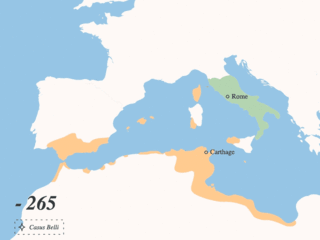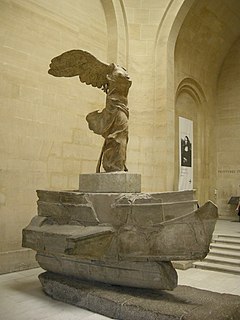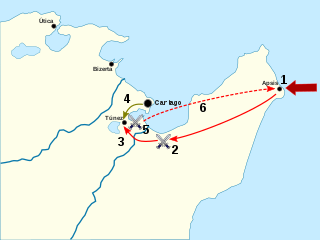Related Research Articles

Classics or classical studies is the study of classical antiquity, and in the Western world traditionally refers to the study of Classical Greek and Roman literature in their original languages of Ancient Greek and Latin, respectively. It may also include Greco-Roman philosophy, history, and archaeology as secondary subjects.

The First Punic War was the first of three wars fought between Carthage and Rome, the two main powers of the western Mediterranean in the early 3rd century BC. For 23 years, in the longest continuous conflict and greatest naval war of antiquity, the two powers struggled for supremacy. The wars were fought primarily on the Mediterranean island of Sicily and its surrounding waters, and also in North Africa. After immense material and human losses on both sides the Carthaginians were defeated.

The Punic Wars were a series of three wars between 264 and 146 BC fought by the states of Rome and Carthage. The First Punic War broke out in Sicily in 264 BC as a result of Rome's expansionary attitude combined with Carthage's proprietary approach to the island. At the start of the war Carthage was the dominant power of the western Mediterranean, with an extensive maritime empire; while Rome was a rapidly expanding power in Italy, with a strong army but a weak navy. The fighting took place primarily on the Mediterranean island of Sicily and its surrounding waters, and also in North Africa, Corsica and Sardinia. It lasted 23 years, until 241 BC, when after immense materiel and human losses on both sides the Carthaginians were defeated. By the terms of the peace treaty Carthage paid large reparations and Sicily was annexed as a Roman province. The end of the war sparked a major but unsuccessful revolt within the Carthaginian Empire known as the Mercenary War.

The Second Punic War was the second of three wars fought between Carthage and Rome, the two main powers of the western Mediterranean in the 3rd century BC. For seventeen years, the two states struggled for supremacy, primarily in Italy and Iberia, but also on the islands of Sicily and Sardinia and, towards the end of the war, in North Africa. After immense material and human losses on both sides, the Carthaginians were defeated. Macedonia, Syracuse and several Numidian kingdoms were drawn into the fighting; and Iberian and Gallic forces fought on both sides. There were three main military theatres during the war: Italy, where the Carthaginian general Hannibal defeated the Roman legions repeatedly, with occasional subsidiary campaigns in Sicily, Sardinia and Greece; Iberia, where Hasdrubal, a younger brother of Hannibal, defended the Carthaginian colonial cities with mixed success until moving into Italy; and Africa, where the war was decided.

The Battle of the Lipari Islands or Battle of Lipara was a naval encounter fought in 260 BC during the First Punic War. A squadron of 20 Carthaginian ships commanded by Boödes surprised 17 Roman ships under the senior consul for the year Gnaeus Cornelius Scipio in Lipara Harbour. The inexperienced Romans made a poor showing, with all 17 of their ships captured, along with their commander.

The Battle of Cape Ecnomus or Eknomos was a naval battle, fought off southern Sicily, in 256 BC, between the fleets of Carthage and the Roman Republic, during the First Punic War. The Carthaginian fleet was commanded by Hanno and Hamilcar; the Roman fleet jointly by the consuls for the year, Marcus Atilius Regulus and Lucius Manlius Vulso Longus. It resulted in a clear victory for the Romans.

The naval Battle of Drepana took place in 249 BC during the First Punic War near Drepana in western Sicily, between a Carthaginian fleet under Adherbal and a Roman fleet commanded by Publius Claudius Pulcher.

The Battle of the Aegates was a naval battle fought on 10 March 241 BC between the fleets of Carthage and Rome during the First Punic War. It took place among the Aegates Islands, off the western coast of the island of Sicily. The Carthaginians were commanded by Hanno, and the Romans were under the overall authority of Gaius Lutatius Catulus, but Quintus Valerius Falto commanded during the battle. It was the final and deciding battle of the 23-year-long First Punic War.

From the 4th century BC on, new types of oared warships appeared in the Mediterranean Sea, superseding the trireme and transforming naval warfare. Ships became increasingly large and heavy, including some of the largest wooden ships hitherto constructed. These developments were spearheaded in the Hellenistic Near East, but also to a large extent shared by the naval powers of the Western Mediterranean, specifically Carthage and the Roman Republic. While the wealthy successor kingdoms in the East built huge warships ("polyremes"), Carthage and Rome, in the intense naval antagonism during the Punic Wars, relied mostly on medium-sized vessels. At the same time, smaller naval powers employed an array of small and fast craft, which were also used by the ubiquitous pirates. Following the establishment of complete Roman hegemony in the Mediterranean after the Battle of Actium, the nascent Roman Empire faced no major naval threats. In the 1st century AD, the larger warships were retained only as flagships and were gradually supplanted by the light liburnians until, by Late Antiquity, the knowledge of their construction had been lost.

The Battle of the Bagradas River, also known as the Battle of Tunis, was a victory by a Carthaginian army led by Xanthippus over a Roman army led by Marcus Atilius Regulus in the spring of 255 BC, nine years into the First Punic War. The previous year, the newly constructed Roman navy established naval superiority over Carthage. The Romans used this advantage to invade Carthage's homeland, which roughly aligned with modern-day Tunisia in North Africa. After landing on the Cape Bon Peninsula and conducting a successful campaign, the fleet returned to Sicily, leaving Regulus with 15,500 men to hold the lodgement in Africa over the winter.
An Ala was the term used during the mid- Roman Republic to denote a military formation composed of conscripts from the socii, Rome's Italian military allies. A normal consular army during this period consisted of 2 legions, composed of Roman citizens only, and 2 allied alae. Alae were somewhat larger than normal legions. From the time of the first Roman emperor, Augustus, the term ala was used in the professional imperial army to denote a much smaller, purely cavalry unit of the non-citizen auxilia corps, see Ala.
The Roman navy comprised the naval forces of the ancient Roman state. The navy was instrumental in the Roman conquest of the Mediterranean Basin, but it never enjoyed the prestige of the Roman legions. Throughout their history, the Romans remained a primarily land-based people and relied partially on their more nautically inclined subjects, such as the Greeks and the Egyptians, to build their ships. Because of that, the navy was never completely embraced by the Roman state, and deemed somewhat "un-Roman".

Latin Rights were a set of legal rights that were originally granted to the Latins under Roman law. "Latinitas" was commonly used by Roman jurists to denote this status. With the Roman expansion in Italy, many settlements and coloniae outside of Latium had Latin rights.

The Battle of Adys was a battle in late 255 BC of the First Punic War between a Carthaginian army jointly commanded by Bostar, Hamilcar and Hasdrubal and a Roman army led by Marcus Atilius Regulus. Earlier in the year, the new Roman navy established naval superiority and used this advantage to invade the Carthaginian homeland, which roughly aligned with modern Tunisia in North Africa. After landing on the Cape Bon Peninsula and conducting a successful campaign, the fleet returned to Sicily, leaving Regulus with 15,500 men to hold the lodgement in Africa over the winter.

The Battle of Panormus was fought in Sicily in 250 BC during the First Punic War between a Roman army led by Lucius Caecilius Metellus and a Carthaginian force led by Hasdrubal. The Roman force of two legions defending the city of Panormus defeated the much larger Carthaginian army of 30,000 men and between 60 and 142 war elephants.

The socii or foederati were confederates of Rome and formed one of the three legal denominations in Roman Italy (Italia) along with the Roman citizens (Cives) and the Latini. The Latini, who were simultaneously special confederates and semi-citizens, should not be equated with the homonymous Italic people of which Rome was part. This tripartite organisation lasted from the Roman expansion in Italy to the Social War, when all peninsular inhabitants were awarded Roman citizenship.

The Siege of Lilybaeum lasted for nine years, from 250 to 241 BC, as the Roman army laid siege to the Carthaginian-held Sicilian city of Lilybaeum during the First Punic War. Rome and Carthage had been at war since 264 BC, fighting mostly on the island of Sicily or in the waters around it, and the Romans were slowly pushing the Carthaginians back. By 250 BC, the Carthaginians held only the cities of Lilybaeum and Drepana; these were well-fortified and situated on the west coast, where they could be supplied and reinforced by sea without the Romans being able to use their superior army to interfere.
The Roman withdrawal from Africa was the attempt by the Roman Republic in 255 BC to rescue the survivors of their defeated expeditionary force to Carthaginian Africa during the First Punic War. A large fleet commanded by Servius Fulvius Paetinus Nobilior and Marcus Aemilius Paullus successfully evacuated the remnants of the expedition, defeating a Carthaginian fleet en route, but was struck by a storm while returning, losing most of its ships.
The Duumviri navales, literally two men who for dealing with naval matters, were two naval officers elected by the people of Rome to repair and equip the Roman fleet. Both Duumvir navales were assigned to one Roman consul, and each controlled 20 ships. It has been suggested that they may have been in charge of the ships of the Socii navales rather than those of the Roman fleet. The position was established in 311 BC by the Lex Decia.
The Ptolemaic navy was the naval force of the Ptolemaic Kingdom and later empire from 305 to 30 BC. It was founded by King Ptolemy I. Its main naval bases were at Alexandria, Egypt and Nea Paphos in Cyprus. It operated in the East Mediterranean in the Aegean Sea, the Levantine Sea, but also on the river Nile and in the Red Sea towards the Indian Ocean.
References
- ↑ Lazenby, John (1998). Hannibal's War: A Military History of the Second Punic War . Oklahoma: University of Oklahoma Press. p. 17. ISBN 9780806130040.
- ↑ Theil, JH (1954). Studies On The History Of Roman Sea-Power In Republican Times. pp. 84–86. ISBN 9333496556.
- ↑ Sandys, John (2015). A Companion to Latin Studies. Cambridge: Cambridge University Press. p. 490. ISBN 9781107497597.
- ↑ Sandys, John (2015). A Companion to Latin Studies. Cambridge: Cambridge University Press. p. 490. ISBN 9781107497597.
- ↑ Clark, Fredrick (1915). The Influence of Sea-power on the History of the Roman Republic. George Banta publishing Company. p. 46.
- ↑ Sandys, John (2015). A Companion to Latin Studies. Cambridge: Cambridge University Press. p. 809. ISBN 9781107497597.